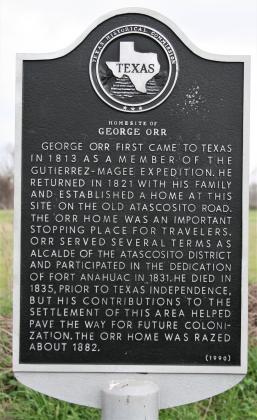Homesite of George Orr
During the years 1812-13, an early filibustering expedition against Spanish Texas was set in motion. It was called the Gutierrez-Magee Expedition and took place against the background of growing unrest in Mexico against Spanish rule. The expedition was organized near Natchitoches, Louisiana to form the nucleus of an invading army. Although not successful, the Gutierrez-Magee Expedition was a major news story in the United States and in fact, was the first time the American people learned about the region known as Texas. The Spanish on their frontiers, long thought only in the abstract, became a reality and were identified with harsh brutality and hostility toward republican values. The failed revolt would have lasting implications on both sides of the border far into the future. It was characterized by private American citizens who created an army to briefly pushed back against monarchical colonization. A young George Orr, born in Pennsylvania and living in Louisiana, was a part of this expedition. During the year 1813, Orr had his first glimpse of Texas.
By 1821, Orr had immigrated to Atascosito and settled near the old Atascosito cross roads where he built a large home and blacksmith’s shop. His league included most of Atascosito Springs with prime land on the eastern and southern portions and on the west, the bottomlands of the Trinity River. Orr offered accommodations to travelers passing through on the nearby road, now known as the “Old Atascosito Road.” Other immigrants arrived in the area between 1824 and 1825, mostly from southwest Mississippi and western Louisiana. George Orr appears to have taken leadership in getting grants for immigrants and organizing the colonists in accordance with Mexican law. Orr wrote Stephen F. Austin in December 1825, asking for a translated copy of the Mexican colonization laws. By March 1826, Austin had written Orr sending the requested colonization laws and asked for patience among the settlers who were anxious to claim their homesteads. In July 1826, Orr and other settlers helped take the first official census of the Atascosito District showing a population of 407 persons. The census takers missed 63 heads of families whose application and character certificates were filed with the district, making close to 500 residents of the district. George Orr and Henry Munson served as joint Alcaldes during this period. George Orr would serve two more times as Alcalde before his death.
At the end of 1831 there were fewer than eight houses in the town of Liberty. Forty-two lots had been granted by the Mexican government, but few homes had been bult. An unknown writer describes Liberty in 1837 as “handsomely situated, with but few inhabitants.” During these years, most of the citizens of the vicinity lived on their plantations, with homes nearest the town being Judge William Hardin’s on his “Mexican Hill” place, less than a mile to the east; the James Martin home a mile to the east; the George Orr place three miles northeast of the town at the original site of Atascosito; the B W. Hardin Home, a mile north of Orr’s; and the Matthew G. White home some four miles southeast of town.
Orr’s friend and fellow Alcalde, Henry W. Munson, died prior to 1831 but his league was granted to his widow, Elizabeth Munson in that same year. Subsequently, George Orr, having divorced his wife, married the widow Munson, and moved to her league on the west side of the Trinity River. Both were very wealthy. Munson was Orr’s third wife. His first wife, Priscilla Clark died in Louisiana; secondly Orr married Marie Tilpah Berwick, daughter of his neighbor Thomas Berwick, who settled in Texas with him until the marriage ended in divorce. Thirdly, he married the widow Munson. While having a bee-infested tree cut on the Munson place, it unluckily fell on Orr and killed him. In the meantime, his first wife, Tilpah Berwick, married the caretaker of her plantation on the Orr league, Benjamin Franklin. By a special Act of the Congress of the Republic of Texas, approved on January 26, 1839, the children of George and Tilpah (Priscilla) Orr, Thomas, William, and Martha Orr, were declared to be their legitimate children and heirs “capable in law of inheriting their parent’s property, in the same manner as if they had been born in lawful wedlock.” It seems the couple had not previously confirmed their marriage vows before a Catholic priest or other civil authority. The homesite of George Orr was an im
portant stopping place for travelers on the Atascosito Road. Orr hosted many early and prominent names in pre-Republic Texas and contributed greatly to the settlement of this area and paved the way for future colonization. Jose Francisco Madero did most of his work granting title to lands and town lots from the home of George Orr as a lodger. The Orr home was razed in about 1882.
Texas Historical Commission Subject Marker Located near the intersection of Hwy. 146 N and F.M. 1011, Liberty, TX.

